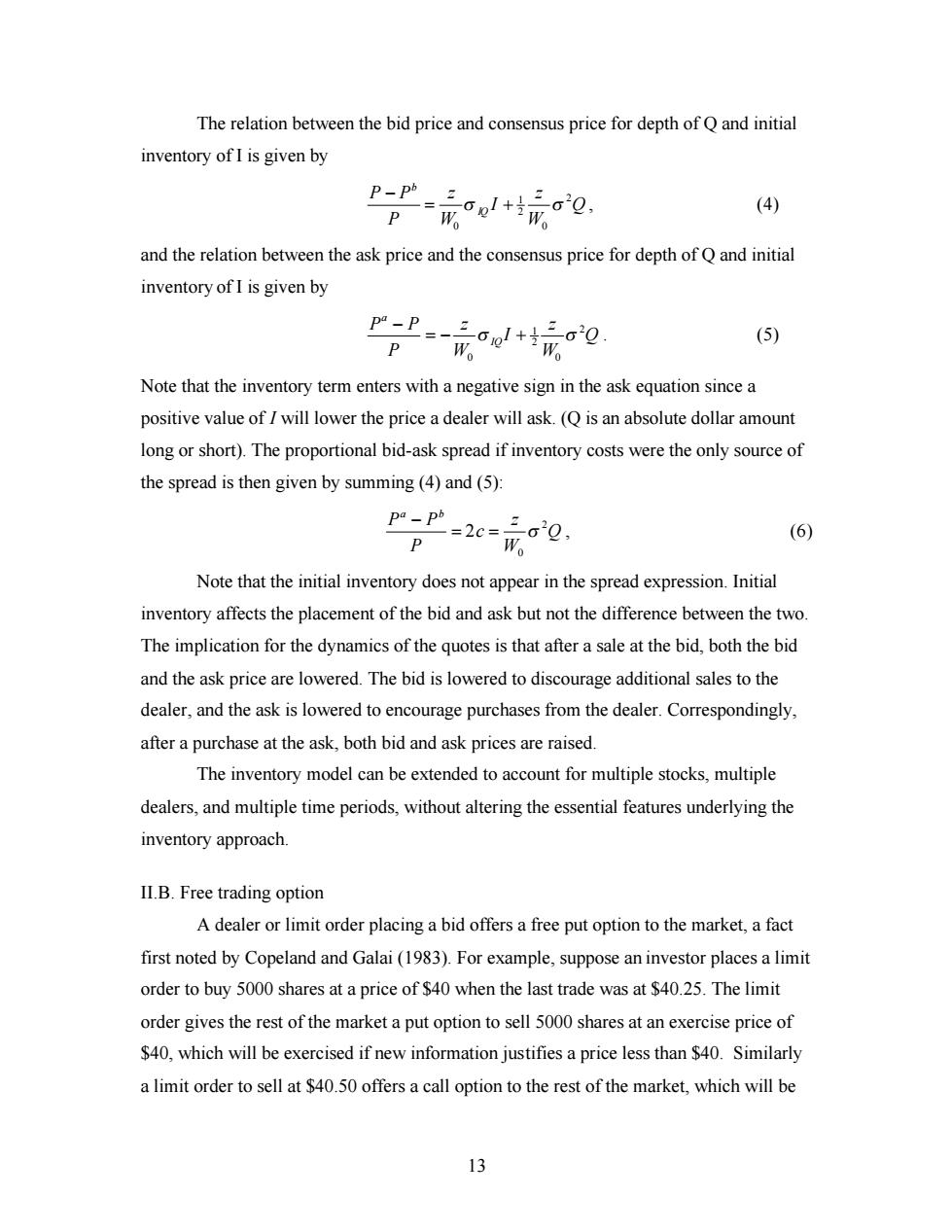正在加载图片...

The relation between the bid price and consensus price for depth of Q and initial inventory of I is given by P-pb P Wo 元o20, (4) and the relation between the ask price and the consensus price for depth of Q and initial inventory of I is given by p4-P -三6@1+形。20 (5) PW。 Note that the inventory term enters with a negative sign in the ask equation since a positive value of I will lower the price a dealer will ask.(Q is an absolute dollar amount long or short).The proportional bid-ask spread if inventory costs were the only source of the spread is then given by summing(4)and(5): p=2c=0, pa-pb (6) W。 Note that the initial inventory does not appear in the spread expression.Initial inventory affects the placement of the bid and ask but not the difference between the two. The implication for the dynamics of the quotes is that after a sale at the bid,both the bid and the ask price are lowered.The bid is lowered to discourage additional sales to the dealer,and the ask is lowered to encourage purchases from the dealer.Correspondingly, after a purchase at the ask,both bid and ask prices are raised. The inventory model can be extended to account for multiple stocks,multiple dealers,and multiple time periods,without altering the essential features underlying the inventory approach. II.B.Free trading option A dealer or limit order placing a bid offers a free put option to the market,a fact first noted by Copeland and Galai(1983).For example,suppose an investor places a limit order to buy 5000 shares at a price of $40 when the last trade was at $40.25.The limit order gives the rest of the market a put option to sell 5000 shares at an exercise price of $40,which will be exercised if new information justifies a price less than $40.Similarly a limit order to sell at $40.50 offers a call option to the rest of the market,which will be 1313 The relation between the bid price and consensus price for depth of Q and initial inventory of I is given by 1 2 2 0 0 b IQ P P z z I Q P W W s s - = + , (4) and the relation between the ask price and the consensus price for depth of Q and initial inventory of I is given by 1 2 2 0 0 a IQ P P z z I Q P W W s s - = - + . (5) Note that the inventory term enters with a negative sign in the ask equation since a positive value of I will lower the price a dealer will ask. (Q is an absolute dollar amount long or short). The proportional bid-ask spread if inventory costs were the only source of the spread is then given by summing (4) and (5): 2 0 2 a b P P z c Q P W s - = = , (6) Note that the initial inventory does not appear in the spread expression. Initial inventory affects the placement of the bid and ask but not the difference between the two. The implication for the dynamics of the quotes is that after a sale at the bid, both the bid and the ask price are lowered. The bid is lowered to discourage additional sales to the dealer, and the ask is lowered to encourage purchases from the dealer. Correspondingly, after a purchase at the ask, both bid and ask prices are raised. The inventory model can be extended to account for multiple stocks, multiple dealers, and multiple time periods, without altering the essential features underlying the inventory approach. II.B. Free trading option A dealer or limit order placing a bid offers a free put option to the market, a fact first noted by Copeland and Galai (1983). For example, suppose an investor places a limit order to buy 5000 shares at a price of $40 when the last trade was at $40.25. The limit order gives the rest of the market a put option to sell 5000 shares at an exercise price of $40, which will be exercised if new information justifies a price less than $40. Similarly a limit order to sell at $40.50 offers a call option to the rest of the market, which will be